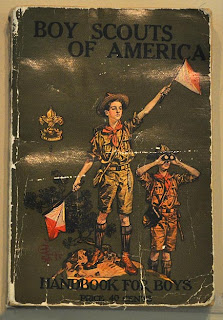 |
| (Sitting on the ground, far right) |
In
the summer of 1927, I discovered the Boy Scout program. There was a large Methodist Church on
the east side of the street that led from downtown Lewiston to the south
hill. It was situated just on the
brow of the hill. One afternoon I
noticed a group of boys on a large green lawn beside the church building. They were practicing signaling with signal
flags. This attracted my attention
so I stopped and watched for a long time.
I finally learned that this was a scout troop in action. Later on that year when I had turned
twelve years of age I joined the scout troop sponsored by the Congregational
Church, in whose choir my Dad and Mother sang. The candle ceremony at my being inducted into the troop and
receiving my tenderfoot badge was very impressive to me.
 |
| Baby Frances |
One of the most important things to happen in
Lewiston was the birth of our one and only sister, Frances Virginia, born on
Dad’s birthday, December 31, 1927.
This was the year that Charles A Lindberg had flown across the Atlantic
from New York to Paris in his Ryan monoplane, the “Spirit of St Lewis”.
The
years that we lived in Lewiston I went from the fourth through the seventh
grades in school. These elementary
grades in school were very enjoyable to me. I don’t remember ever having any difficulties or bad
experiences in school. It was a
happy time for me. An interesting
custom in those days was for all the children to line up at the entrance of the
school, when the bell rang for school to start and then march into the building
to the strains of the military march played on a phonograph.
 |
| Lewiston Relief Society |
The
sixth and seventh grades were in the Junior High School building. It was during my years in Junior High
that I became an avid sports fan.
The Junior High was near the High School. After school I used to watch the High School football,
basketball and baseball teams practice in their respective seasons. During those two years the High School
had State champion football and basketball teams. I didn’t miss one of their games. In those days there were no half time shows during the half
time intermissions at the basketball games. During this intermission, the audience, which sat in the
balcony, would throw pennies and nickels down onto the playing floor for the
young boys to scramble after. I
usually got my share of the coins.
There
was no branch of the Mormon Church in Lewiston when we moved there, and it
wasn’t until 1927 that one was organized under the direction of the
Northwestern States Mission President William R Sloan. It was called the Lewis and Clark
Branch. In this little branch,
Mother was called as Relief Society secretary and Dad installed as the Sunday
School Superintendent.
 |
| Frances and her mother (Virginia) |
|
 |
| Frances' graduation 1945 |
|
|
|
 |
| J Ray and Frances Cox |
|
 |
| The FE Ericksen family |
|














